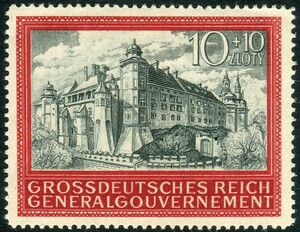GERMANY 1930s, DARKENING CLOUDS

President von Hindenburg, seen as the grand uncle and father figure of the nation, presided over a nation which, from the late 1920s until 1932, still balanced between socialism, democracy, nationalism, and SA gang rule at street level. Industry began to flourish as confidence grew and more finance reached national building projects. Stamp issues glorified the dramatic flights of the Graf Zeppelin to the North Pole and to South America.
The Bauhaus still survived, though local politics forced it to move location. The arts still flourished, though Jewish conductors and professors began to find life difficult. Allied forces left the Rhineland by 1930 (SG 459/60). The 85th birthday of President von Hindenburg was celebrated by a definitive set with his portrait in 1932 (SG 478/84). Well received, this design continued in use with changed colours from 1933, year of the birth of the new III Reich.
But a secret lies literally within the paper of those stamps. The first 1933 Hindenburg printings were made with the traditional mesh watermark, used since 1922. But within a year something invisibly altered in those stamps, reflecting the dramas now unfolding within the Reich.
1933 : a year of momentous change. January- Hitler made Chancellor. February - the Reichstag (which had remained as a political balance to Hitler's party) was burned down. Decrees were now passed cancelling many German civil rights. 1st March - mass arrests of political opponents. March - Hitler burned the republican flag, replacing it with the Imperial and swastika flags jointly. Dachau camp received its first inmates. The Enabling Act gave Hitler dictatorial powers. April - laws banned non-Aryans from positions in the law and the civil service. The Gestapo established. May - book burnings, eugenic sterilisation began. In August the 5th Nurnberg Rally opened as the "Reichsparteitag des Sieges" (Victory of the Nazi Party).
The Hindenburg stamps secretly reflect the events - the watermark was transformed to a swastika design at the end of 1933. The old hero had little time to dwell on these changes to his stamps, he died on 2nd August 1934. Within hours, Hitler revoked the title of President and made himself Fuhrer in its place, with total and unlimited powers.
To combat socialism, workers organisations became trade guilds (SG 551/59). Stamp designs now tended to depict images of Germanic history, maidens in folkloric costumes, castles, ancient historic buildings. Curiously, the Hindenburg definitives survived until 1941, when finally ousted by a Hitler portrait. But Hindenburg stamp booklets had already carried labels, propaganda exhorting postal users to support national political campaigns.
Territorial acquisition was the turning point in the Reich's expansion but eventual downfall. Claims for the Sudetenland, Austria (Anschluss), Danzig, Memel had a logic - the local populations mainly spoke German. But the desire to be part of the Reich was not universal. Then, a quest for pre-WWI lost lands in the East led to the invasion of Poland, war with Russia and the West, most of Europe embroiled in warfare, occupation, resistance.
Many pages of a collection can be devoted to the issues of WWII Occupied territories or the Axis partners. Broadly speaking, the more distant from Berlin, the shorter the occupation and the more limited the printing runs. Accordingly, the stamps from WWII Albania had low print runs, were hardly put into use, and are scarce. In the Balkan area, generally the German Army control was never more than partial and dominated by guerrilla warfare against local partisans. Stamps which tell a story, including the even rarer local liberation overprints.
In the last year of the war, a few philatelic flowers bloomed in the harshest of conditions. For example, the last stamp of WWII Poland (Generalgouvernement), the 1944 Cracow Castle (SG 477) is an act of propaganda (fifth year of Nazi rule) but still a superb work of engraved art, produced in the skilled workshops of the Vienna State Printing Works. A glorious image but the end of the tragedy.
- Published
- 10/02/22 01:52:00 AM
